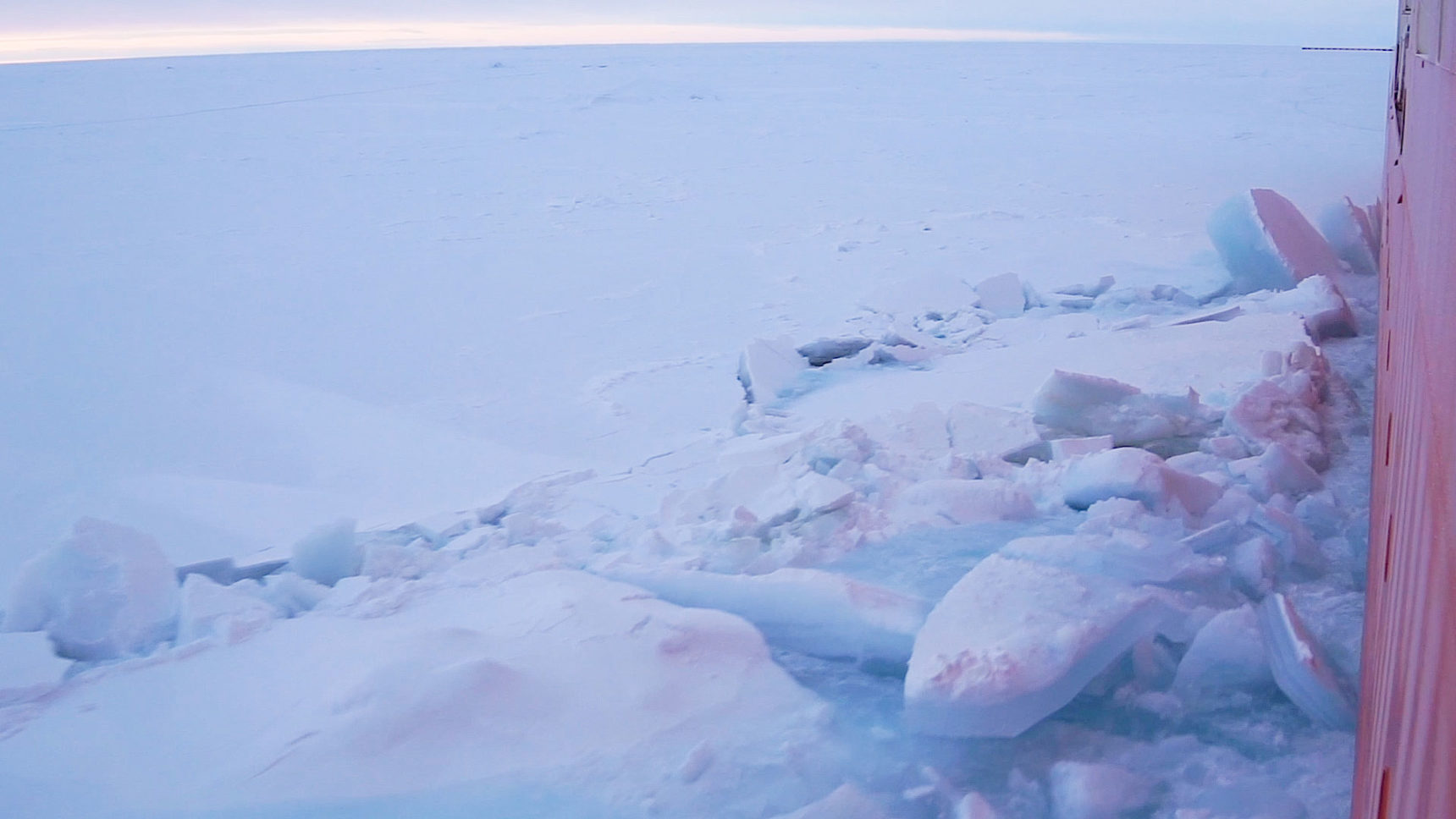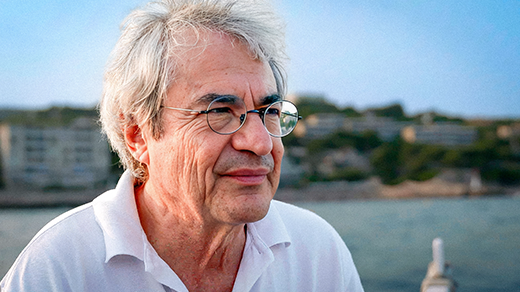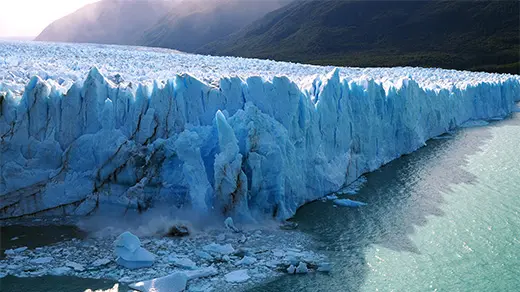The Voyage to the End of Ice
Introduction
“Pull out your ice picks,” a scientist whispers in the inky twilight. We’re standing on 30 centimeters of ice — a thin veneer that separates us from the deadly Arctic Ocean below — and the ice is trembling. It emits a loud popping sound as a crack starts to spread tens of meters away.
Unsure what the ice will do next, I fumble for my picks, but they’re tucked away in the front pockets of my snowsuit and hidden below my thick life vest. When I finally pull them out, my chest is pounding and my mind is racing as I picture one worst-case scenario after another. Up here, 600 kilometers north of the nearest chunk of land, a dip into water that hovers just above minus 1.8 degrees Celsius does not sound appealing.
After a moment, the ice quiets, and we’re left in the stillness of the mid-October dusk. Ian Raphael, a graduate student from Dartmouth College, lets out a deep breath. “That was wild, dynamic and terrifying,” he says with a gleeful, almost childlike smile.
The radio in his front pocket gurgles as other researchers announce the sudden appearance of the fissure. We piece together that it runs at least 500 meters across the ice. At its widest, it’s 5 centimeters across, but as we approach it, we can see that it’s growing. The ice floe has cracked in two.
To the untrained eye, the floe appears vast and unchanging. In nearly every direction, a sculpture garden of snow and ice stretches toward the horizon, where it collides with a sunless sapphire-blue sky. But few landscapes are more dynamic than the Arctic ice cap, a mosaic of small floes only a few kilometers across. These constantly shuffle about — they knock into one another, tear past one another, and fracture into shards. These changes are the prelude to summer, when the ice undergoes another radical change: It begins to melt.
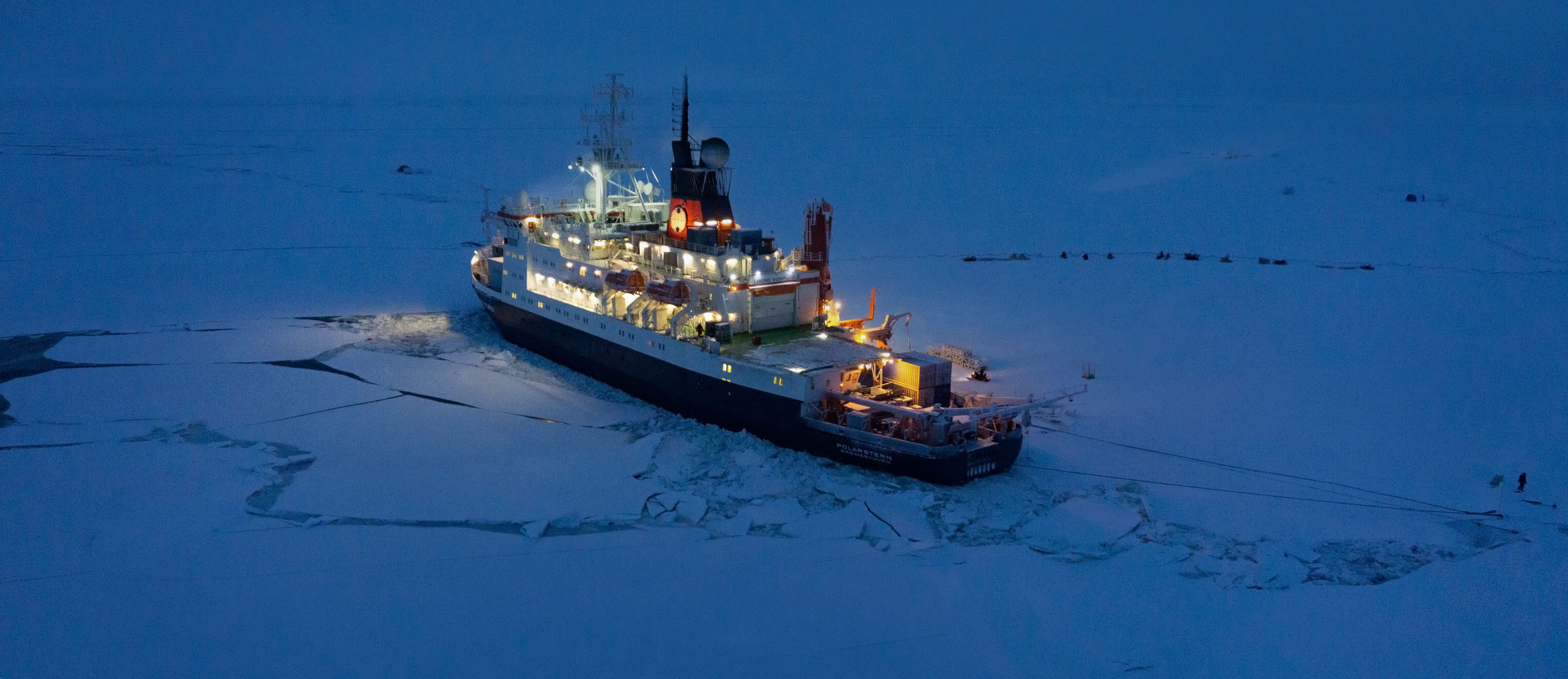
The icebreaker Polarstern the morning after a crack cleaved the ice floe in two, sending some experiments into the water.
Every spring, the sun peeks above the horizon for the first time in months, and its warm rays cause the sea ice to retreat. In the fall and winter, the ice grows back. But this cycle is out of step. Today, more sea ice is lost during summer than is regained during winter — causing sea ice to shrink overall.
Higher temperatures triggered this change, but the physics of ice exacerbates it. Widespread melting exposes huge swatches of dark ocean water. Unlike thick ice, the water has a low surface reflectivity, or albedo, and absorbs sunlight rather than reflecting it. That absorption further warms the ocean and spurs additional ice melt in a vicious cycle that scientists refer to as a positive feedback loop. “These are processes where you can take a small nudge to a system and magnify it into a big shove,” said Donald Perovich, an engineering professor at Dartmouth.
But while the ice-albedo feedback loop is simple in theory, a number of complexities play into it, including ice thickness, the different types of ice, the presence of snow and clouds, and the physical interactions that govern those complexities. Slowly, scientists have begun to incorporate these intricacies into their simulations. “In early climate models, the poles were just sort of painted white,” said Marika Holland, a climate scientist at the National Center for Atmospheric Research in Boulder, Colorado. Then scientists added details and quickly found that these changes affected the outcome of their models. The inclusion of aerosols and melt ponds alone reduced the thickness of sea ice by 1 meter and melted more summer sea ice, according to a simulation co-authored by Holland in 2012.
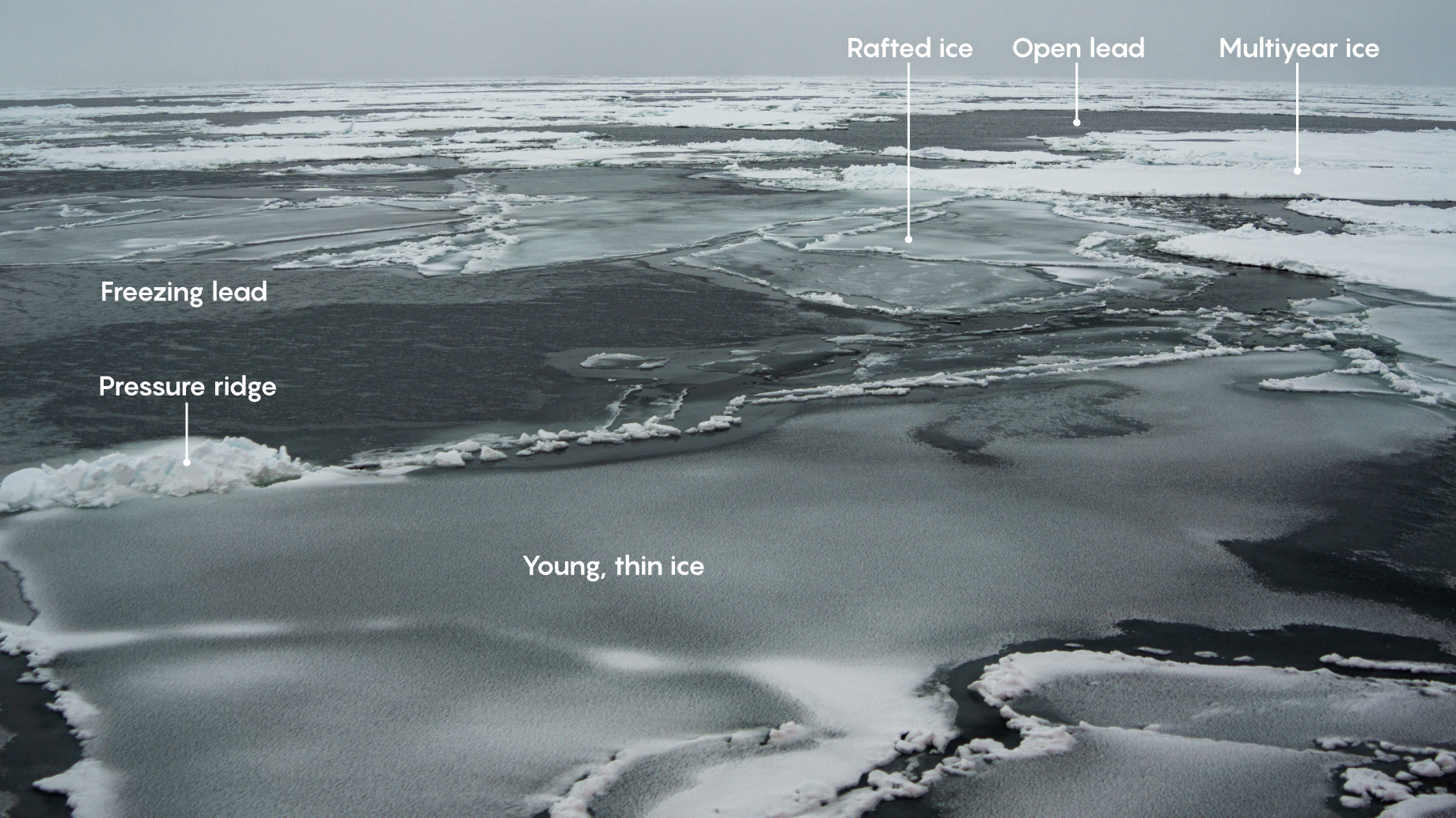
Various types of sea ice will behave in unique ways. Multiyear ice tends to be thick, sturdy and reflective. Young, thin ice is darker and absorbs more energy from the sun. Rafted ice happens when the wind pushes thin sheets of ice on top of each other. Leads are large cracks that open between ice floes. When the ice pushes back together, it can form pressure ridges — small mountain chains of ice.
Yet despite these recent improvements, our understanding of these and other feedback loops is still far too crude. That much can be seen in the variety of outcomes that various models predict. Some forecast that summer sea ice will continue to exist until sometime in the 22nd century. Others predict it will be lost within the next 10 years.
Whenever it happens, the transformation will affect the entire planet. An increasingly dark Arctic Ocean will amplify warming in the Arctic. It has the potential to thaw Greenland’s glaciers, which will push the sea level higher, and to melt global permafrost, which will release huge volumes of heat-trapping gases into the atmosphere. An ice-free Arctic will likely scramble weather patterns across the globe, producing periods of punishing cold, brutal heat and disastrous storms at lower latitudes. In an extreme case it could even cause the Gulf Stream to shut down, plunging much of Europe into colder weather. “This is the Day After Tomorrow scenario,” said Michel Tsamados, a sea ice expert at University College London.
Depending on the physics of ice, many of these effects could happen as soon as this decade.
To get a better handle on the timeline, scientists are spending one year in a German icebreaker that has been trapped within the sea ice at the top of the globe. On that mission, which I joined for six weeks in September and October, they are monitoring the Arctic in order to better quantify the ice-albedo feedback loop, as well as a number of other Arctic unknowns. The hope is to use the on-the-ice measurements to calibrate remote data, such as satellite images, and to more deeply understand the complexities of pack ice so as to make climate models even more precise.
“It isn’t just an intellectual exercise,” said Perovich, who pointed to the huge disruptions happening right now in Inuit communities. “We’re trying to understand things that are having consequences on people today.”
The New Arctic
We entered the edge of the ice pack on the evening of September 26. The thin ice first appeared as an oily sprinkle of crystals that sparkled in the sunlight. It gradually thickened until it formed a thin black film. At this point, it could still bend, allowing waves from a passing ship to ripple through it. The ice continued to grow as we motored north until it became hard and white. Here, waves tossed the ice around — grinding it into round plates called pancake ice or pushing thin sheets on top of one another to create an interlocking pattern, a phenomenon known as finger rafting. One dictionary floating around the ship included descriptions and drawings of 99 different types of sea ice.
By the next morning, we started to pass giant floes, as though we were breaking through a vast, white continent that was crisscrossed by polar bear tracks. I was onboard a Russian icebreaker, the Akademik Fedorov, which was helping with the initial setup of the mission (known as the Multidisciplinary Drifting Observatory for the Study of Arctic Climate, or Mosaic). Together, the Akademik Fedorov and the German icebreaker, the Polarstern, sailed from Tromsø, Norway, in mid-September and headed toward the central Arctic. The first task was to find a floe so strong and so thick that the Polarstern could steer into it and the captain could kill the ship’s engines — entombing the vessel within the ice for a full year.
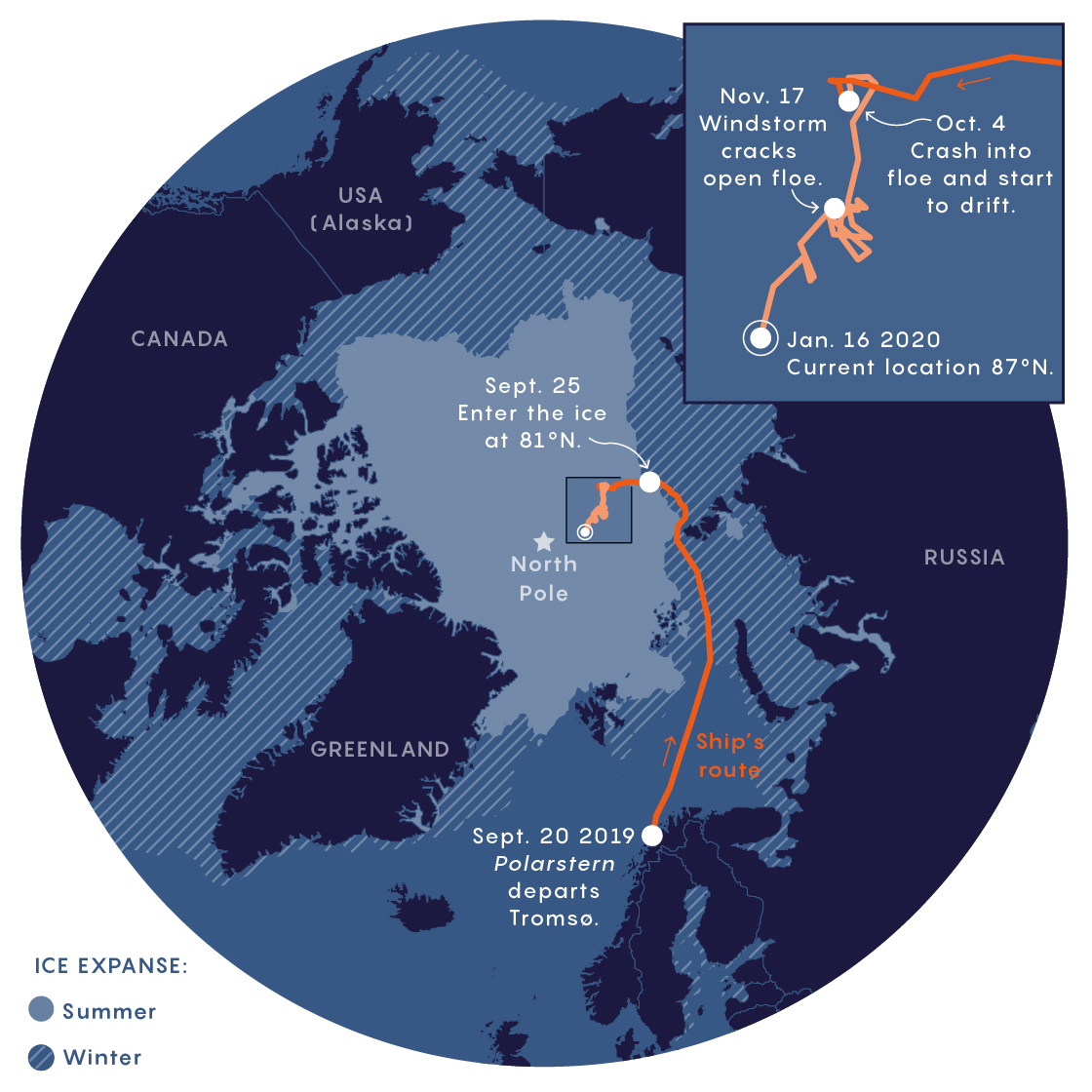
The Mosaic expedition is the first climate expedition to spend a full year in the central arctic. The expedition centers around the Polarstern, a German icebreaker that locked into an ice floe in early October. Various research stations have been set up on the floe surrounding the ship, which will drift along with the ice through September.
Lucy Reading-Ikkanda/Quanta Magazine. Source: Alfred-Wegener-Institut / Martin Künsting (CC-BY 4.0); Mosaic Expedition
It should have been relatively straightforward. In late September, at our latitude, the sea ice should be around 1.6 meters thick, according to predictions made by the National Oceanic and Atmospheric Administration. Yet for days we searched in vain for an ice floe just 1 meter thick. Helicopter reconnaissance missions analyzed more than a dozen floes, but every one of them was less than 0.5 meter thick. Mooring a ship to a floe so thin would be dangerous — strong winds would shove the ship through the ice, destroying any research stations.
The difficulties threw into stark relief the lack of multiyear ice within the central Arctic Ocean. “The old ice is almost entirely gone,” Tsamados said. “That’s not alarmist — that’s a fact.” Over the past three decades, the oldest and thickest ice has declined by a stunning 95%. That much can be garnered from satellite observations, but satellite observations can be imperfect. Satellites typically measure ice thickness with a special radar, which is supposed to penetrate snow. If it doesn’t, scientists can mistake snow for ice and overestimate the ice thickness.
Snow creates other complicating factors. At its simplest, snow acts like a blanket, preventing heat from the relatively warm water from escaping into the atmosphere. (Its insulating properties, after all, make it excellent material for an igloo.)
In 2012, Melinda Webster, a scientist at the University of Alaska, Fairbanks, set out to study how snow cover affects the growth of sea ice. In a small lagoon connected to the Chukchi Sea — a spot protected from the complicating factors of wind and ocean currents — her team found that thick snow stunts the growth of sea ice. The thinner the ice is, the more it’s sensitive to snow’s insulating effects.
Yet scientists can’t say whether snow is increasing or decreasing in the Arctic. On the one hand, open water releases more moisture into the atmosphere, which causes more precipitation. But because there is less ice, there is a smaller surface on which to accumulate snow.
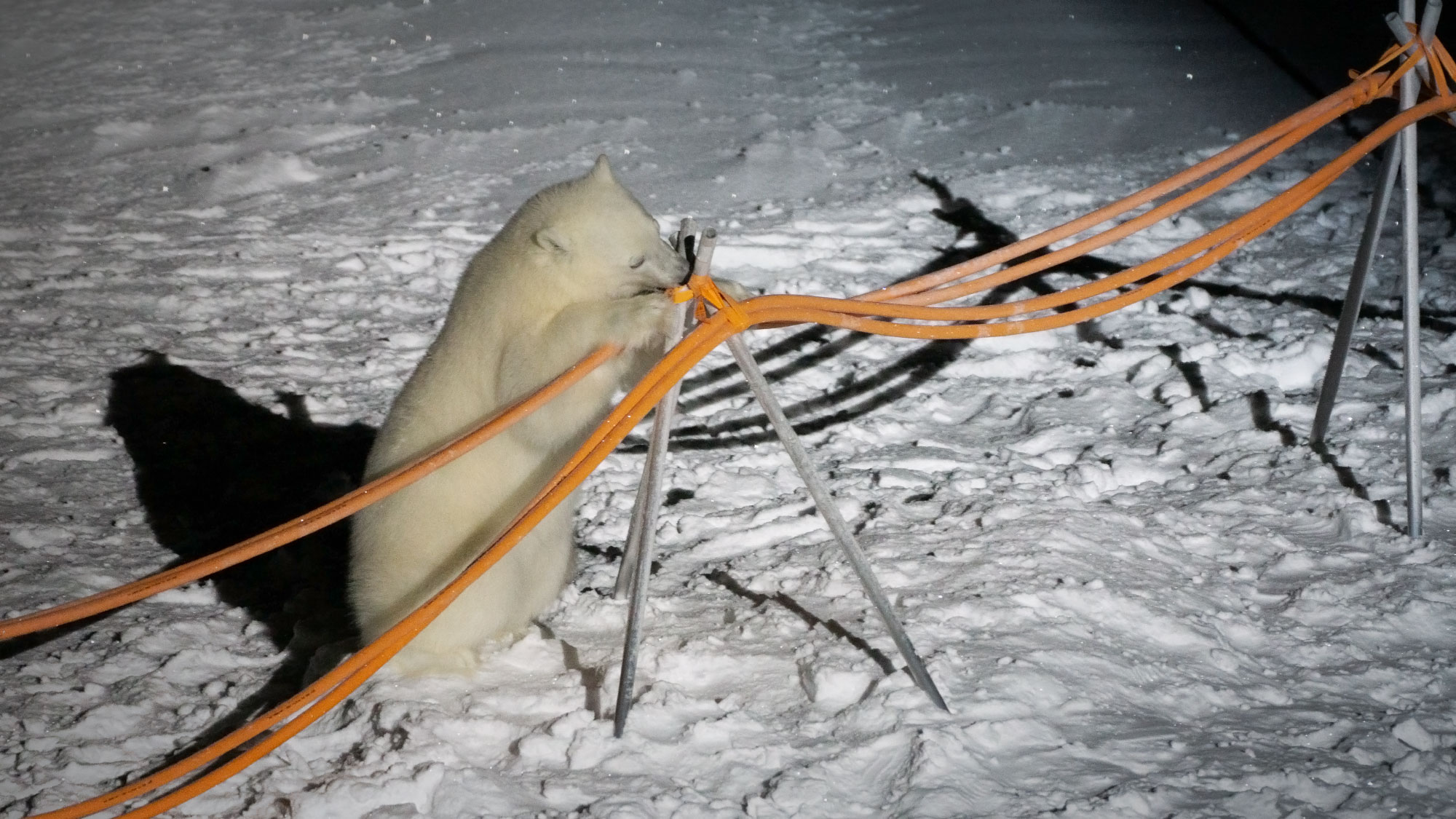
Polar bears are a constant concern on any arctic expedition. The curious animals can damage equipment and electrical cables, and they have no fear of humans.
The role of snow also appears to be seasonal. In the fall, storms drop buckets of snow onto the sea ice, but in midwinter, those storms decrease. Another complication is the heterogeneity of the snow. When we first entered the polar ice cap, I expected to see a blanket of snow that stretched toward the horizon and masked the different types of sea ice. But the thickness of the snow varied wildly. In areas where there was open water or recently frozen sea ice, there was no snow at all. Near mountains of ice, the snow would pile up into large foothills.
The distribution of the snow is “like folding up your blanket four times thick over your shoulders, and then leaving the rest of you uncovered completely,” said Christopher Polashenski, a geophysicist at Dartmouth. “You would probably get kind of cold from that.” Under those circumstances, you might be able to grow quite a bit of ice, even though there is plenty of snow around.
The Ice Is Alive
Shortly after the Polarstern crashed into a floe (which was finally deemed thick enough), scientists set up research stations on the ice. They built huts and raised colorful tents, all connected by a complex network of paths and power lines — a small, floating city.
Marcel Nicolaus, a sea ice scientist from the Alfred Wegener Institute in Germany (which is leading the Mosaic mission), selected a site just 300 meters from the bow and a little to the starboard side. From there, his team planned to drop a remotely operated vehicle — dubbed the Beast — into a hole in the ice. The Beast’s sonar will map the topography of the bottom layer of the ice — and with it, the ice thickness, which plays a crucial role in the ice-albedo feedback loop. Thin ice absorbs more light than it reflects. It therefore melts quickly in comparison to thick, white ice.
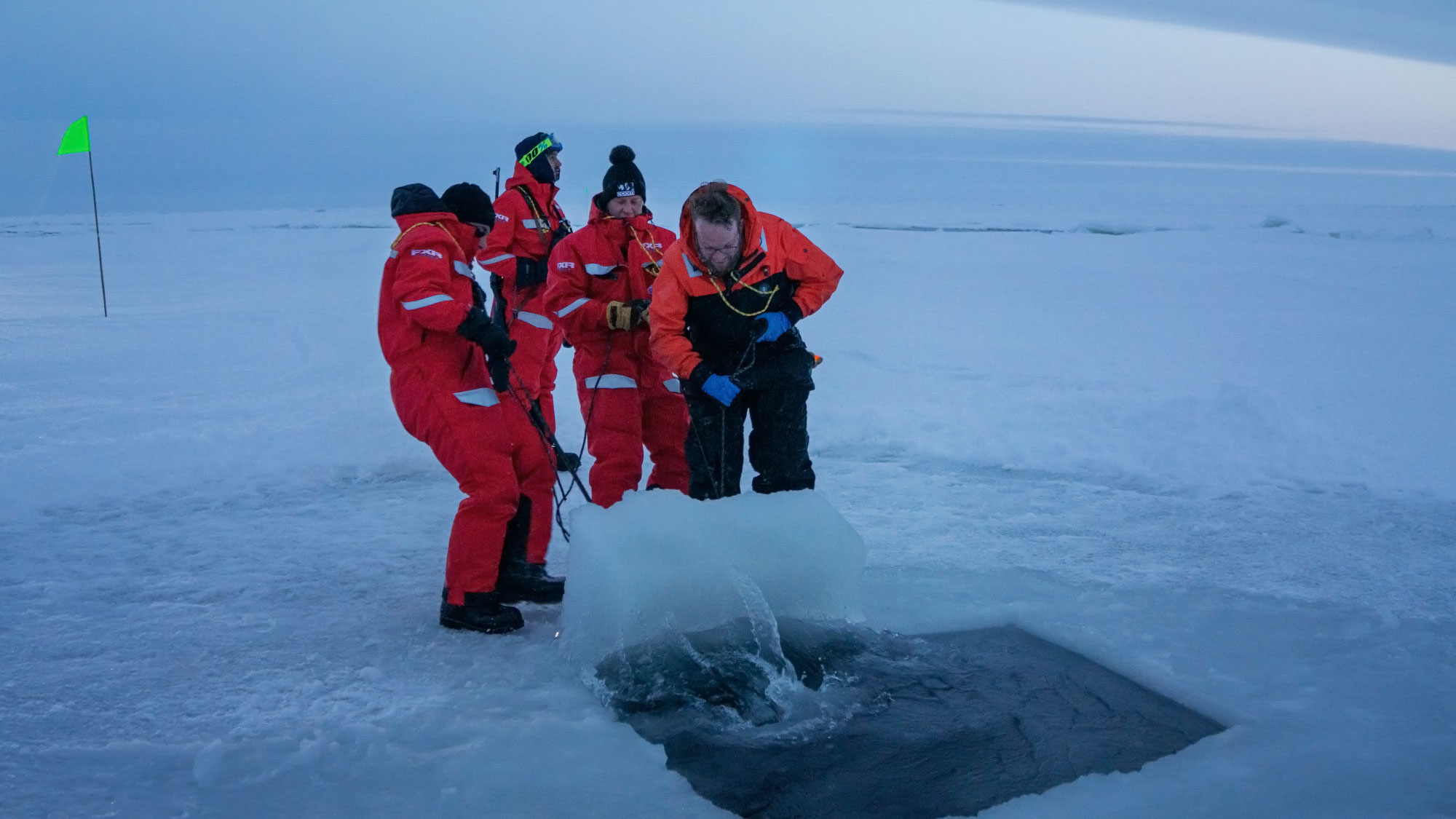
Three scientists open a hole in the ice for the Beast — a submersible that will map sea ice thickness from below — while a sentry watches for polar bears.
Raphael, by contrast, was scanning the ice and snow from above in order to see how the albedo and the snow change through the seasons. Shortly after we reached the floe, he selected a site to mount a rotating laser — a cylinder that looks almost like R2-D2 — on a 7-foot-tall tripod. The scan maps tens of thousands of points and will eventually cover an area the size of about 20 football fields. The goal is to repeatedly map the area over the year, allowing scientists to watch the surface move as snow builds up and features like dunes shift below the bellowing wind. In the summer, the map will also reveal surface melt. “You’ll get this incredible three-dimensional map of how the surface is melting at tens of thousands of points,” Perovich said. As the ice melts, dark ponds form on the surface. Eventually the ice becomes so porous that the ponds drain through the ice — transforming the surface back to white. Then more ice melts, and the process continues.
To prepare Raphael’s site, we trekked along its perimeter one morning as a pink glow hung on the southern horizon, while an orange moon loomed low to the north (not to set for 12 days). It was relatively warm, meaning that you could work without added layers covering your face and even take off your mittens for up to a minute at a time. The work seemed easy that day, and Raphael sang Christmas tunes as he towed a sled full of instruments in his puffy red snowsuit. Little did we know that a crack would open within the ice in a matter of minutes.
This seasonal breathing of the ice — pond melt, snow, and the opening and closing of cracks — influences another critical feature of the Arctic climate. When a particularly large crack, or lead, opens in the ice, it releases a rush of warm air and moisture into the atmosphere: fuel for clouds.
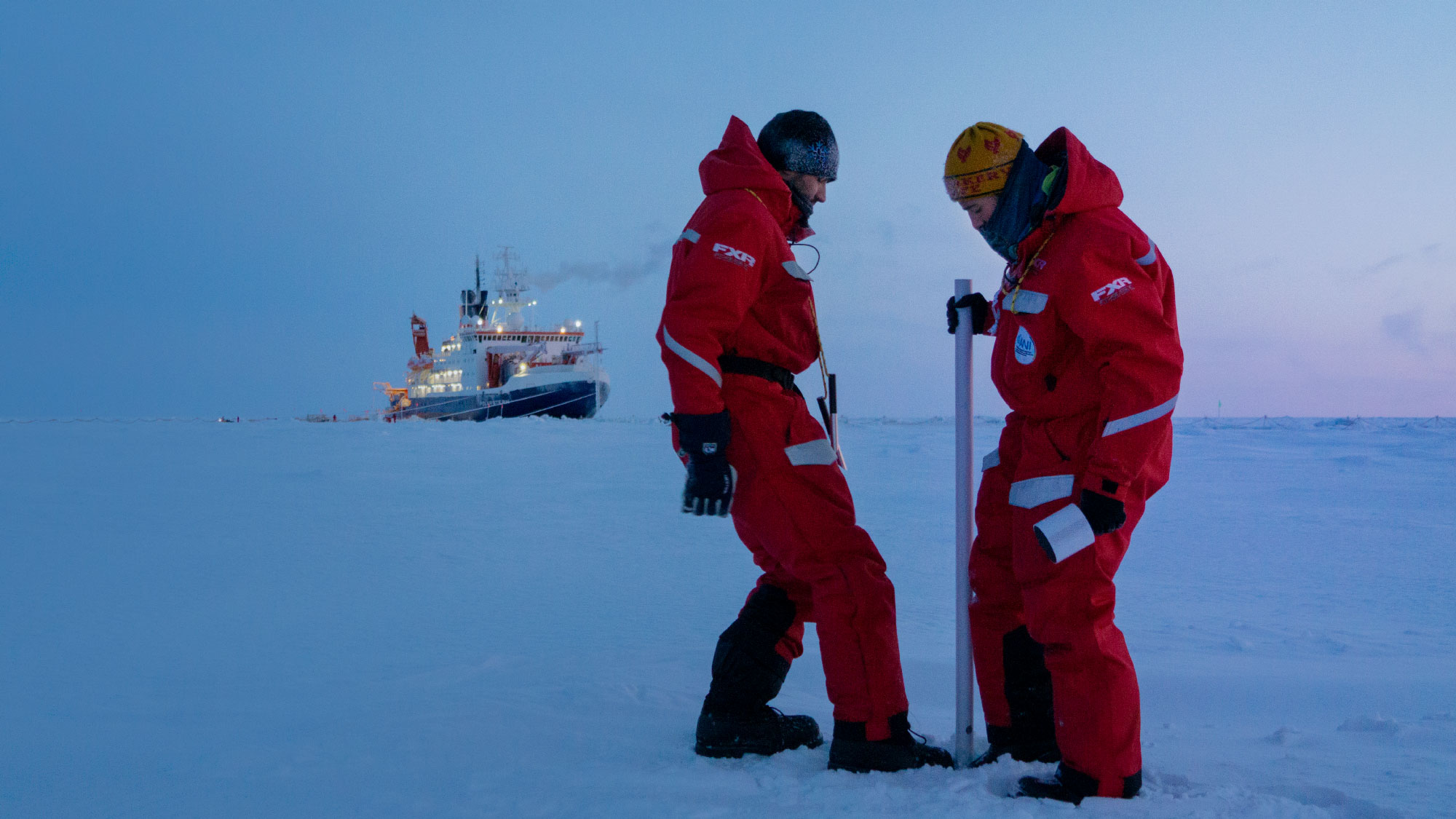
Ian Raphael (right) and David Wagner, a Ph.D. student at the WSL Institute for Snow and Avalanche Research SLF in Switzerland, prepare their laser-scanning site.
Because of this, many scientists have hypothesized that a warming Arctic will lead to a cloudier Arctic. You might think that the clouds would limit the amount of warming: Clouds — like thick, white ice — reflect solar radiation back into space. As a result, they might allow the Arctic to remain relatively cold.
Instead, the opposite appears to be true, argues Patrick Taylor, a climate scientist at NASA’s Langley Research Center in Virginia. In 2015, Taylor and his colleagues used NASA’s Calipso and CloudSat satellites and found that open water forms clouds in the fall and winter — when there’s little to no sunlight to block — but that the open water creates fewer clouds in the summer. The reason is simple. “If you take your mug of hot cocoa outside and the temperature is minus 20 degrees Fahrenheit, you see huge amounts of evaporation,” said Jennifer Kay, a climate scientist at the University of Colorado, Boulder. Whereas if you take your mug out on a hot summer day, you don’t. It has to be hot compared to the atmosphere for evaporation to occur. And in the colder seasons, the Arctic Ocean is downright balmy.
The winter clouds thus act as a blanket, trapping heat within. Taylor argues that the clouds therefore amplify the ice-albedo feedback loop. Open water in the fall and winter forms clouds, which warm the surface, which leads to more open water in future seasons and more blanketing clouds.
Sun, cracks, snow, floes, clouds, wind — all of them work together, interacting with one another, to dictate the most critical thermal control system on the planet. “It’s as though we’ve got the most complicated puzzle you can think of,” said Perovich, “and everybody has some of the pieces.”
Blowing in the Wind
Around 4 a.m. the day after the ice cracked beneath my feet, the thin veneer of ice started to explode with deafening booms that woke up the ship. Before I left for the trip, I spoke with a number of Arctic researchers who told me to listen to the ice. I thought that meant I had to kneel down on the ice and put my ear against the floe — that the ice would whisper to me. But the ice does not whisper. It screams. Whenever the pressure builds up, you can hear a large hissing sound — almost like the screeching from an exploding soda bottle. It sizzles. It pops. It groans. And it does so loudly. A polar bear standing in the distance likely would have heard something akin to thunder.
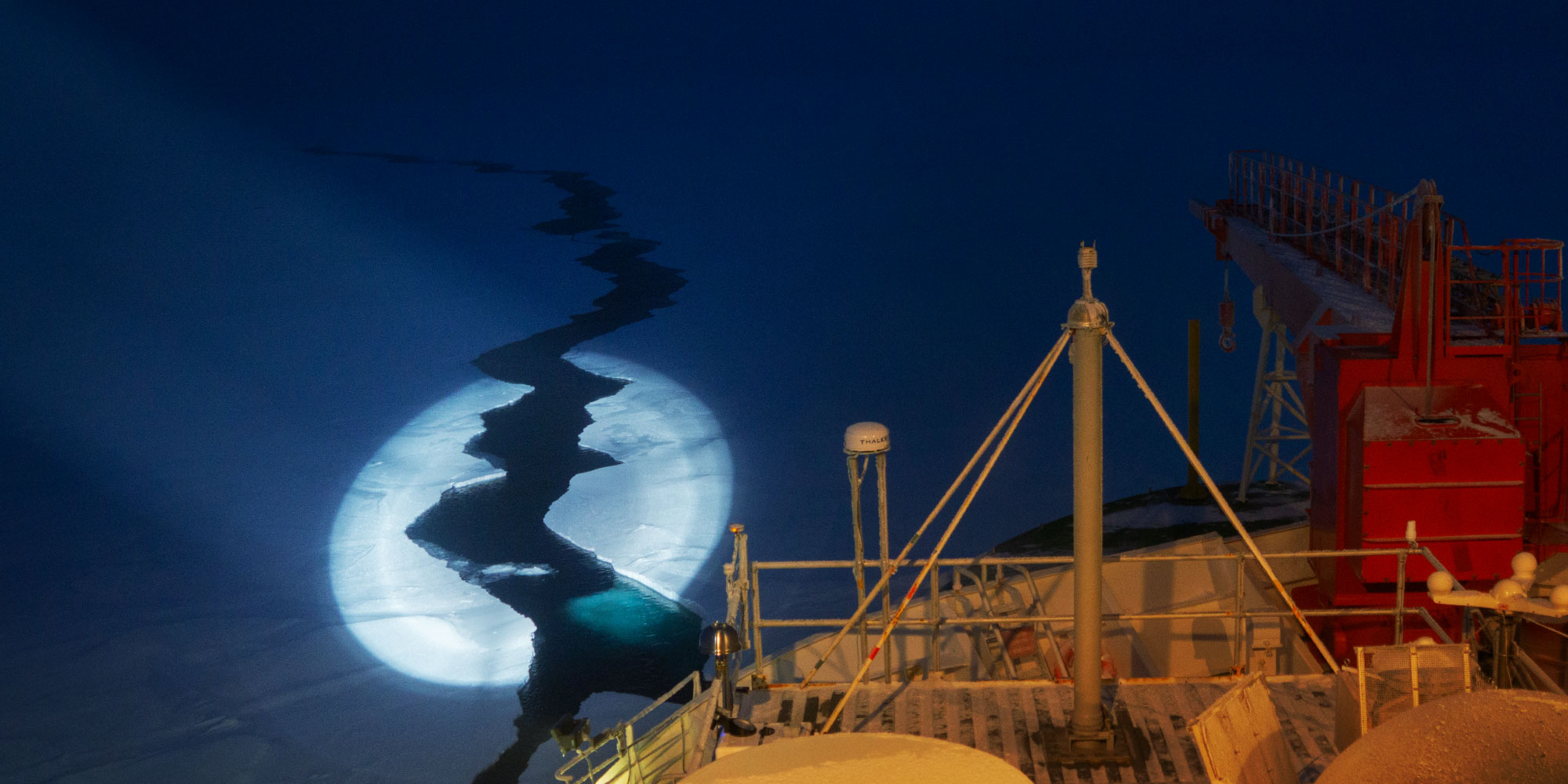
On October 7, a lead cracked open. It would soon close and re-open and then close again.
For several hours, the ice on the port side of the ship scraped past the hull, forcing the ship back and pulling the anchor lines taut in front of the bow. The captain started the engines for the first time since we froze into the floe and steered the ship toward the anchors to keep the lines from snapping. Eventually the ice slowed to a halt. But soon after, the 10-meter-wide crack that now ran from the horizon toward the bow of the ship — essentially dividing the ice on the port and starboard sides into separate floes — closed shut. The two separate floes then tumbled together to build small mountains of turquoise blocks of ice. “There was a lot of pressure on the ship,” said Byron Blomquist, an atmospheric scientist at the University of Colorado, Boulder. “Good thing it’s an icebreaker, otherwise we would have been crushed like a walnut.”
In only a few hours, the ice had changed dramatically. No one was allowed on the ice that morning, but around 8 a.m., I jumped in the helicopter with Markus Rex, an atmospheric physicist at the Alfred Wegener Institute and the leader of the Mosaic expedition. We flew over the floe to assess the damage. Polar night had settled in, and we could only see with the help of the ship’s lights and the faintest glow of twilight, which transformed the landscape into a deep-sea blue. Our birds-eye view revealed a new world. To the port side of the ship was open water. To the starboard side were a number of cracks and a mountain chain of ice that overran the nearby power lines.
The ice is truly alive. And according to researchers like Polashenski, all this motion influences the ice-albedo feedback loop. Those mountain chains of ice that form when floes tumble into one another build thicker ice that’s harder to melt. Open cracks of water freeze into thin ice, which then melts quickly the following summer. Ridges sculpt snowbanks blown in by the wind. The dynamics of the sea ice might become even more powerful as the ice thins — creating yet another feedback loop. Thinner ice, after all, is more easily tossed about. In the fall and winter, it will open more leads. In the summer, it will melt more quickly. The cycle intensifies with each passing year.
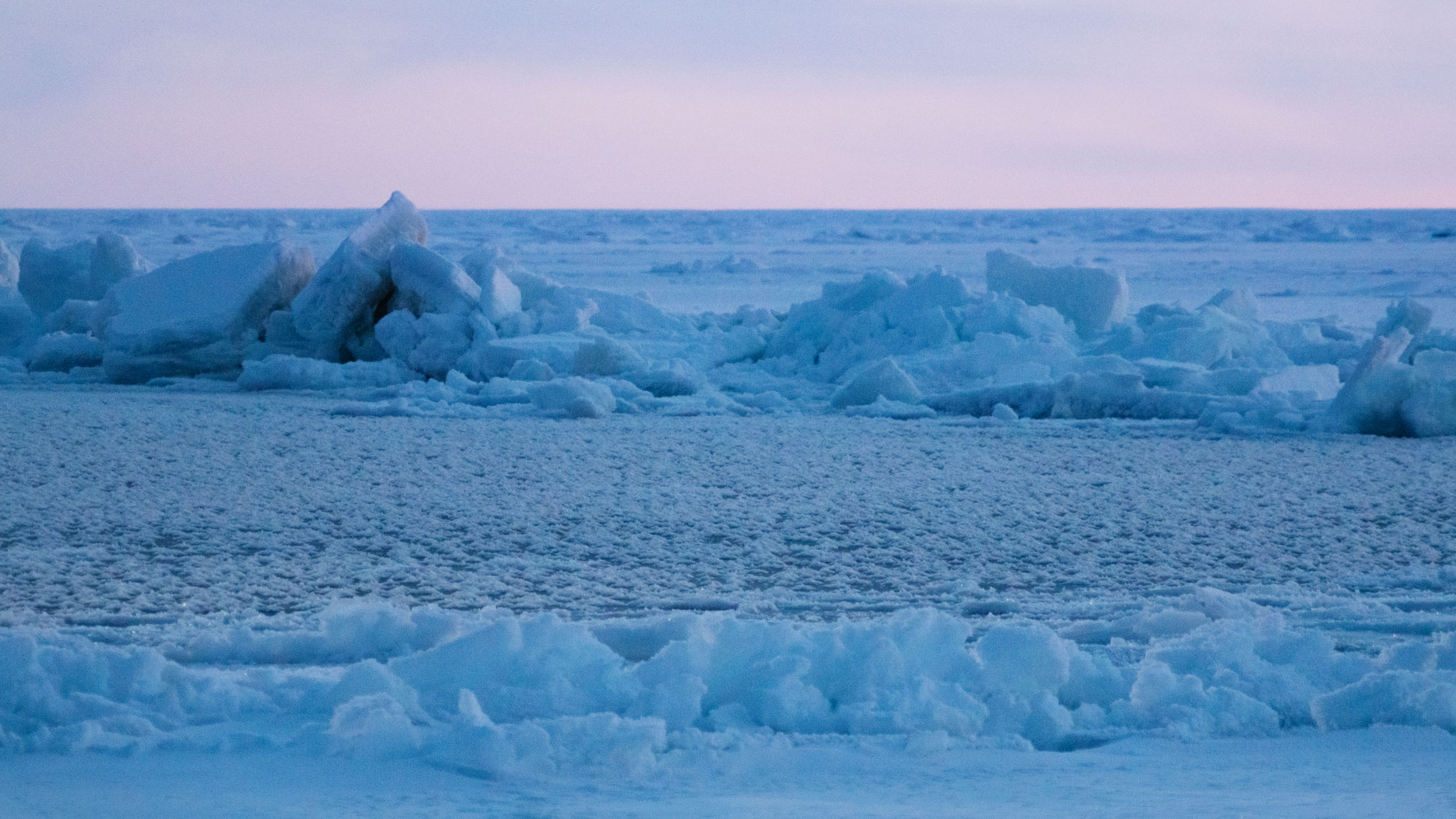
An open lead in the ice begins to freeze over, with thick black ice smothered in frost flowers. This lead had already closed into a pressure ridge once, as evidenced by the large chunks of ice piled on either side. It would soon close again.
To better understand the dynamics of the sea ice, Polashenski has an instrument set up on the ice that fires a pulse of lasers at a number of targets roughly 1 kilometer away to measure how their distances change over time — tiny changes that augur breakups within the ice. Other scientists have set up buoys in the ice that will report a position via GPS satellites, allowing them to watch the ice as it opens, closes, shears and rotates.
With the number of windstorms Mosaic scientists have already witnessed, the data set is a scientist’s dream, though the work has been exceedingly difficult. On November 17, one month after I left, a lead opened through the middle of the camp. It was manageable at first. Scientists built bridges to cross it. Then it began to shear, sending the ice in front of the ship from the starboard side to the port side. “It was like a parade,” Raphael said via WhatsApp (the best form of communication on board the ship). Several sites lost power. Raphael’s field was torn apart.
“There’s this duality where it’s so intensely frustrating to watch all of your work literally ripped apart, your measurements interrupted, your instruments destroyed,” Raphael said. “But simultaneously it’s powerful and destructive and fluid and beautiful — like watching a big river in spring runoff.” This, after all, is why many scientists signed up. “This is what sea ice science is,” he said. “It’s why it’s so challenging and hopefully, in the end, rewarding.”
Raphael eventually rebuilt his field, and in time, all the observations from the expedition — from snow thickness to ice dynamics — will be fed into climate models to help forecast our future. I thought about that future as I headed home. We left the sea ice late at night, and I watched the world transform from thick ice floes to the small round plates called pancake ice and eventually to open water. A breathtakingly beautiful world disappeared in a matter of hours, and I might never see it again. Even if I make it back 10 years from today, it might look vastly different. It might not be there at all.
This article was reprinted on Wired.com and Spektrum.de.
